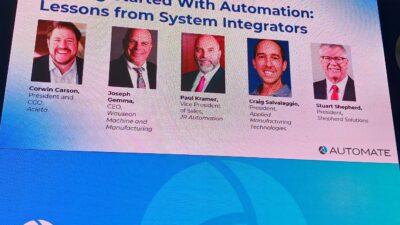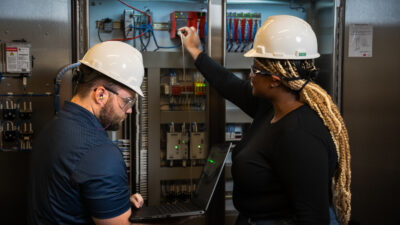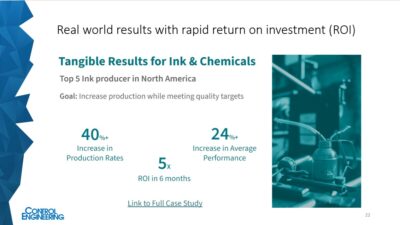Smart sensors enable accurate, efficient, and expansive data collection. Smart sensing solutions can preserve signal integrity in harsh industrial environments and give customers quick and easy solutions for test and measurement and other big data applications.

The Internet of Things (IoT) and big data are upon us and, in parallel, smart sensors have a growing influence in everyday life. Whether it’s the rollout of the latest smart watch, the thermostat that learns household habits and adjusts heating and air conditioning accordingly, the utility meter that broadcasts wirelessly, or the smartphone app that provides an alert when the garage door is left open, smart sensors are responsible for collecting data and making it readily available.
Traditional sensors such as thermocouples, resistance temperature detectors (RTDs), strain gages, linear variable differential transducers (LVDTs) and flowmeters measure physical parameters and provide data needed to monitor and control processes. Many of these produce low-level analog outputs that require precision signal conditioning to preserve the critical information they are gathering. Signal conditioning functions include sensor excitation, signal amplification, anti-alias filtering, low-pass and high-pass filtering, linearization, and an often overlooked but essential feature—isolation. Once signal conditioning has been performed, sensor signals can be digitized using an analog-to-digital converter and then further processed by a data acquisition system.
System on a chip
Developments in electronics are rapidly changing the way process data is collected using sensors. Microcontrollers and microprocessors have become much more sophisticated, incorporating communications interfaces, excitation sources, high-resolution analog to digital (A to D) and D to A converters, general purpose discrete I/O, fast architectures, math support, and low-power modes. Commonly called SoC, or system-on-chip, these small devices outperform the full and half-length ISA and PCI card solutions of yesterday at a much reduced cost. Microcontrollers with integrated data converters are even available in packages as small as 2 mm x 3 mm.
So what does all this mean for smart sensors and data acquisition? How are these changes in electronics technology changing the way data is acquired and used?
First, let’s understand what a smart sensor is. Smart sensors analyze collected measurements, make decisions based on the physical parameter being measured, and most importantly, are able to communicate. Local computational power enables self-test, self-calibration, cancellation of component drift over time and temperature, remote updating, and reconfiguration.
Widely distributed
Low-cost and low-power electronics allow signal conditioning to occur much closer to the sensor, or even within the sensor package itself. This enables processing power to be widely distributed throughout a data acquisition system, resulting in far more signal processing capability than was previously possible. Systems are flexible and scalable and sensor packages are rugged, leading to high reliability. Long bundles of sensor wires composed of carefully routed twisted-shielded pair wiring with specific shield grounding requirements now can be replaced with fewer wires that connect to multiple sensors and don’t have as stringent routing and shielding needs. Since low-level analog signal lines can be short with smart sensors, environmental electrical noise coupled into signal lines is avoided and signal integrity is preserved. When conditioned sensor data format and a smart sensor communication standard are defined, physical parameters measured with a wide range of sensors becomes universal. In a nutshell, smart sensors make data acquisition systems easy to design, use, and maintain.
Smart sensors
Smart sensors may be thought of as discrete elements like an intelligent thermocouple or accelerometer with integrated electronics, but in a broader sense, smart sensing and smart signal processing at the system level also are rapidly evolving with advances in electronics. Data acquisition systems used to rely on host computer software to perform complex calculations on measured data. Now, individual signal conditioning input and output modules commonly interface to between 1 and 32 sensors and perform signal processing functions within a module, remote from a host computer.
Signals can be locally monitored for alarm conditions with programmed actions taken when limits are reached. In addition, high-performance signal conditioners provide essential sensor signal isolation required in harsh industrial applications and protect against transient events, such as electrostatic discharge (ESD) or secondary lightning strikes, as well as extreme overvoltage.
SoC microcontrollers and microprocessors in a data acquisition system have integrated peripherals for communicating over Ethernet, USB, CAN, and other fieldbuses. Fast processors, math support, and local memory allow control functions, such as proportional-integral-derivative (PID) algorithms, to reside and execute within a system control module and operate in parallel with communication to individual I/O modules and host computer software applications. Many systems are moving toward true stand-alone capability where no host computer is required to run application software. Data acquisition and control is fully contained within the data acquisition system with application software running on system resources and user interface occurring simply through a web browser from anywhere in the world.
Higher cost, safety considerations
As with any technology, smart sensors have disadvantages. Integration of electronics with sensors drives up system costs. When retrofitting existing installations, costs to change wiring can be significant. New hardware and systems have learning curves for optimal operation. Safety and compliance to regulatory standards may prohibit smart sensor use. Each application needs to be individually analyzed with costs weighed against benefits, but in general, smart sensors and smart systems are changing the way data is collected and will work their way into new and existing applications.
The world is hungry for more data. The need is omnipresent in industrial applications, manufacturing, laboratories, medical applications, and now even in our homes. Data is used to automate processes and expand capabilities. Data analysis tells us about health of system components, efficiency of processes, and fault conditions.
Signal integrity
Smart sensors enable accurate, efficient, and expansive data collection. More than ever, smart sensors and smart sensing are the future of data acquisition and processing.
Smart sensing solutions can preserve signal integrity in harsh industrial environments and give customers quick and easy solutions for test and measurement applications. Products that help with this include signal conditioning modules, and data acquisition and control systems, and data communication products have some of the best performance metrics in the industry while maintaining low cost. Products remove analog problems from systems design and development and provide a better user experience for data acquisition and control.
– John Lehman, engineering manager, Dataforth; edited by Mark T. Hoske, content manager, CFE Media, Control Engineering, [email protected].
Key concepts
- Smart sensors and data acquisition help with Internet of Things (IoT) and big data.
- System-on-a-chip capabilities distribute intelligence to sensors.
- Integrity of signals from sensors ensures proper information.
Consider this
Can smart sensors help with your data collection and big data efforts?
ONLINE extra
Control Engineering has a data acquisition page.
See related articles linked below.



